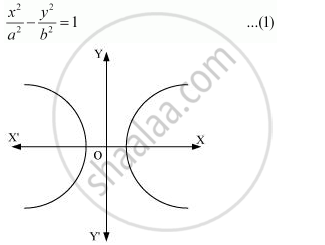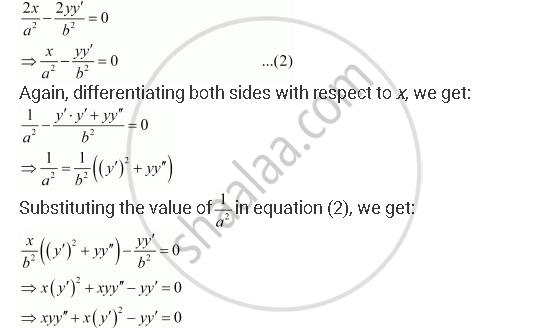Advertisements
Advertisements
Question
Form the differential equation of the family of hyperbolas having foci on x-axis and centre at origin.
Solution
The equation of the family of hyperbolas with the centre at origin and foci along the x-axis is:

Differentiating both sides of equation (1) with respect to x, we get:

This is the required differential equation.
APPEARS IN
RELATED QUESTIONS
Form the differential equation of the family of ellipses having foci on y-axis and centre at origin.
Form the differential equation of the family of curves represented by y2 = (x − c)3.
Form the differential equation corresponding to y = emx by eliminating m.
Form the differential equation from the following primitive where constants are arbitrary:
y2 = 4ax
Form the differential equation from the following primitive where constants are arbitrary:
y = cx + 2c2 + c3
Form the differential equation from the following primitive where constants are arbitrary:
y = ax2 + bx + c
Form the differential equation corresponding to y2 = a (b − x2) by eliminating a and b.
Form the differential equation corresponding to y2 − 2ay + x2 = a2 by eliminating a.
Represent the following families of curves by forming the corresponding differential equations (a, b being parameters):
x2 − y2 = a2
Represent the following families of curves by forming the corresponding differential equations (a, b being parameters):
y2 = 4a (x − b)
Represent the following families of curves by forming the corresponding differential equations (a, b being parameters):
y = eax
Show that y = bex + ce2x is a solution of the differential equation, \[\frac{d^2 y}{d x^2} - 3\frac{dy}{dx} + 2y = 0\]
Find the equation of a curve passing through the point (0, 0) and whose differential equation is \[\frac{dy}{dx} = e^x \sin x\]
Find one-parameter families of solution curves of the following differential equation:-
\[x\frac{dy}{dx} - y = \left( x + 1 \right) e^{- x}\]
Find one-parameter families of solution curves of the following differential equation:-
\[x\frac{dy}{dx} + y = x^4\]
Find one-parameter families of solution curves of the following differential equation:-
\[\left( x + y \right)\frac{dy}{dx} = 1\]
Find one-parameter families of solution curves of the following differential equation:-
\[e^{- y} \sec^2 y dy = dx + x dy\]
Find one-parameter families of solution curves of the following differential equation:-
\[x\frac{dy}{dx} + 2y = x^2 \log x\]
Find the area of the region bounded by the curves (x -1)2 + y2 = 1 and x2 + y2 = 1, using integration.
Form the differential equation representing the family of curves y = e2x (a + bx), where 'a' and 'b' are arbitrary constants.
Find the differential equation of the family of curves y = Ae2x + B.e–2x.
Find the differential equation of the family of lines through the origin.
Find the equation of a curve whose tangent at any point on it, different from origin, has slope `y + y/x`.
Find the equation of a curve passing through the point (1, 1) if the perpendicular distance of the origin from the normal at any point P(x, y) of the curve is equal to the distance of P from the x-axis.
The solution of the differential equation `2x * "dy"/"dx" y` = 3 represents a family of ______.
Find the equation of a curve passing through origin and satisfying the differential equation `(1 + x^2) "dy"/"dx" + 2xy` = 4x2
Find the equation of a curve passing through (2, 1) if the slope of the tangent to the curve at any point (x, y) is `(x^2 + y^2)/(2xy)`.
Find the equation of a curve passing through the point (1, 1). If the tangent drawn at any point P(x, y) on the curve meets the co-ordinate axes at A and B such that P is the mid-point of AB.
Family y = Ax + A3 of curves is represented by the differential equation of degree ______.
The differential equation `y ("d"y)/("d"x) + "c"` represents: ______.
The curve for which the slope of the tangent at any point is equal to the ratio of the abcissa to the ordinate of the point is ______.
The differential equation representing the family of circles x2 + (y – a)2 = a2 will be of order two.
Differential equation representing the family of curves y = ex (Acosx + Bsinx) is `("d"^2y)/("d"x^2) - 2 ("d"y)/("d"x) + 2y` = 0
From the differential equation of the family of circles touching the y-axis at origin
Form the differential equation of the family of hyperbola having foci on x-axis and centre at origin.
